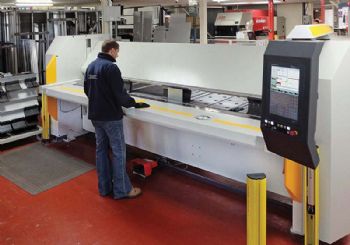
At the Telford factory of Proteus Switchgear, the throughput of bent sheet-metal components is just as high using a manually operated CNC folding machine as it was when the company was using a fully automated panel bender.
Purchased through sole UK agent Press & Shear Ltd, Tamworth (
www.pressandshear.com), the manual FlexiBend 73.30 all-electric model built in Germany by RAS Reinhardt took over from the automatic hydraulically actuated machine from another supplier in January 2016.
The new folding centre is providing not only equivalent productivity but also greater flexibility for bending small to medium-size batches of switchgear cabinet components.
Typical runs are from 10- to 20-off — and occasionally up to 50-off. The machine also achieves better bending precision, helped by its rigid construction and by a patented ‘intelligent’ crowning system (its sensors measure and compensate automatically for folding-beam deflection).
Positional accuracy is within ±0.1mm, and there is no error at all in the bend angles; they are checked manually after the first operation using a set square or template, allowing offset values to be entered into the control.
The occasional problem of hydraulic-fluid leakage from the previous machine has been eliminated; and because the FlexiBend is all-electric, it draws power only when it is in operation, other than the miniscule amount needed for the control screen.
For over 25 years, Proteus Switchgear has specialised in the design, development and production of electrical switchgear for factories, universities, hospitals, offices, shops and houses. The company offers standard and bespoke units that provide flexible, reliable, energy-efficient power distribution solutions to architects, consultants and facilities managers world-wide.
Andy Roberts, Proteus Switchgear’s CNC programmer, said: “Our automated folding machine was nearing the end of its useful life, and to replace it would have cost 500,000 euros. In contrast, the FlexiBend was one-third of the price. We were concerned that, being a manual machine, it would not be able to keep up with production, so we retained the automated machine for a while to work alongside it.
“However, we only used it two or three times in the first four months after delivery of the FlexiBend, so we had it taken out. Automated machines are space-hungry, so it has freed a lot of factory space for other activities, such as material storage and assembly of our switchgear cabinets.”
The new machine has the added advantage of being able to bend material up to 3,200mm long, compared with 2,100mm on the automated machine. Proteus Switchgear can now produce 2.5m-long frame sections and cover panels for its cabinets without resorting to a standard press brake, which is inconvenient when handling such large components.
The new folding machine provides more flexibility for the production of smaller parts as well. With the automated bending machine, a minimum area of 200 x 150mm was required for the clamping tool; there is no such restriction with the FlexiBend. Proteus Switchgear produces a lot of end plates that are 130mm wide; previously, these parts had to be bent on press brakes, which was less efficient.
Contrasting the use of the FlexiBend with that of a press brake, Mr Roberts says the latter requires special tooling to produce, for example, a hemming bend or a radius bend. “Such full-width tools are expensive to buy and are heavy, making exchanging them time-consuming, which in turn reduces productivity and profitability.
“The manual folding machine, on the other hand, needs only two sets of standard, segmented tools in the upper beam to produce all of our parts. Even a radius bend can be produced by repeated hits with a sharp tool, a sequence that
is worked out automatically by the RAS control software.”
One set of tools, comprising mainly ‘goats-foot’ and sharp segments, is reserved for folding mild steel up to 2.5mm thick. They remain on the machine for most of the time, as most of the material at the Telford factory is between
0.9 and 1.5mm thick. The other tool set is for producing components between 2.5 and 3mm — the maximum thickness the machine can process.
Swapping over the tools takes less than 5min, as they are clamped automatically in the beam; and because it is an easy matter to adjust the positions of the tool segments (each up to 200mm long), a number of sections can be
created along the length of the machine.
The technique allows material of various widths to be folded at the different stations, without the part ever leaving the operator’s hands, avoiding unnecessary handling.
The design of the machine means the operator does not have to push heavy sheets through from the front. Instead, they can be loaded from the rear using the integrated sheet support table and back-gauge, which incorporates pop-up fingers that position the workpiece before each bend.
Proteus Switchgear chose a J-shaped table configuration to improve access to the tooling and allow single-handed manipulation of heavy sheets.
After a program starts, a graphic on the control screen shows the operator which foot switch needs to be pressed. The lower beam and the folding beam with their sets of segmented tooling automatically adjust within 10sec to suit the material thickness, while the back-gauge positions the blank for the first bend. The folding beam moves at 90deg per sec.
Programming the machine simply entails drawing the part on the control’s touch screen, after which software works out the bending sequence and simulates it, flagging up any potential collisions. Built-in technology tables take into account material spring-back.
A 3-D image of the finished part is displayed for verification before production starts. On-screen instructions are provided for tooling adjustment, as well as details of which tooling segments are required to achieve the tool length the operator has programmed.
The information is stored with the folding program ready for re-use. Press & Shear also supplied Proteus with RAS software for off-line PC-based programming.